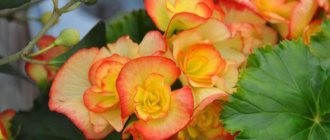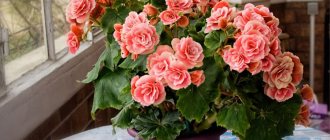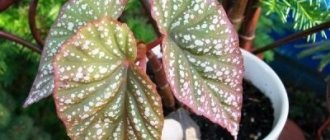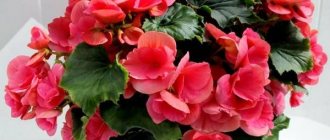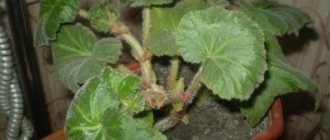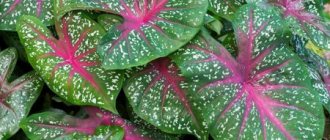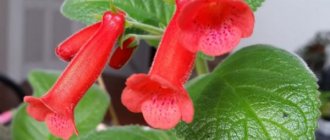Currently, many varieties of ever-flowering begonia have been bred, including those resistant to the temperature conditions of the cool summer of the middle zone.
Such varieties are cultivated as annuals , grown indoors and then planted outdoors in the spring, once the threat of frost has passed.
When the autumn cold snaps, the plants are removed.
Well-preserved strong specimens, which will serve as a source of cuttings for the growth of the next summer season, are sent for a warm winter.
- The following varieties of ever-flowering begonia are most suitable for such cultivation:
- Alba is tall, up to 40 cm, spreading, with dark green foliage and white flowers, collected in groups of 12 pieces.
- Kate Teicher - grows to a height of 40 cm, green leaves edged with red. The inflorescences are red, thirteen-flowered.
- Carmen is a medium-growing (25 cm) variety with very dark, lilac-brown foliage and pink flowers clustered in groups of six.
- Othello - 25 cm stems bear bright scarlet flowers that bloom in abundance.
- Albert Martin is a low-growing (15 cm) variety, green leaves with a red edge. Bright carmine-purple flowers are united in inflorescences of nine pieces. Up to 55 flowers unfold simultaneously on one plant.
- Bella is low (19 cm), decorated with green leaves bordered by red and dark pink nine-flowered inflorescences. 140 flowers can bloom at the same time.
- Bicola is a low-growing (13 cm) variety with green foliage and white flowers edged with pink, in clusters of four.
At the same time, even more numerous “ever-flowering” varieties are grown indoors .
Home care
Lighting
Bright light is needed. The best lighting will be provided by windows facing east or southwest . On windows in northern directions, as well as during the season of short daylight hours, for “eternal flowering”, additional lighting is needed - so that the light period is 16 hours a day. On the south and south-east side, shading may be required - especially in high summer.
Temperature
The best temperature range throughout the year is from 20 to 25 degrees. How to preserve ever-blooming begonia in winter?
In winter, you need to protect the root system from hypothermia (for example, on a cold windowsill), and in summer , prevent overheating of the stems and leaves .
If begonia semperflorens is kept in winter with short daylight hours, you need to switch it to rest mode - keep it at a temperature of 12 to 15 degrees, but not lower: a temperature of +12ºС is critical for an initially tropical plant.
Priming
The plant does not have any special requirements for the soil substrate: it must be slightly acidic, sufficiently loose, nutritious, with good air and moisture permeability .
You can use ready-made soil for begonias , or garden soil with a good dose of perlite or vermiculite, and also prepare a mixture of equal parts of leaf soil, humus and sand.
Landing
The planting container may be wide rather than deep (plant roots develop in the surface layer of soil), with a mandatory drainage hole . Since stagnation of water is extremely unfavorable, it is better to choose a porous container material - ceramics without a continuous layer of glaze .
A drainage layer must be placed at the bottom of the container , then soil is poured into a small mound, on top of which a predominantly horizontal root system is placed and the soil mixture is added to the required level, gradually compacting it.
In one container you can plant several plants quite close to each other - with a minimum feeding area of 10x10 cm for each.
Transfer
Replant as they grow : young specimens more often, mature specimens less frequently, up to the point of replacing the replanting with a partial renewal of the surface layer of soil in the pot. In this case, as a rule, old plants lose their decorative properties and are replaced by young ones grown from cuttings.
Watering
Water moderately, mainly in the morning or evening. The main goal in this case is to prevent the soil and root system from drying out, or stagnation of moisture in the soil.
Between watering with soft, not cold water, the soil should dry out a little.
If in winter this begonia is in a dormant period, at a temperature of 12-15 degrees and short daylight hours , the frequency of watering should be reduced .
Air humidity
It is necessary to maintain an atmosphere of high humidity , similar to the “native” tropics, but direct spraying of the bush does not benefit either the leaves or flowers: dark spots appear on them.
You should spray water around the begonia , or place wide vessels with water nearby, and place the pot on a tray with moistened pebbles.
Top dressing
Feed the plant once a month with a weak solution of mineral fertilizers with a slightly reduced nitrogen component. Potassium and phosphorus, necessary for flowering plants, must be present in full.
If the wintering of the ever-flowering begonia is warm and light , do not stop .
Growth and pruning
This species does not grow higher than 40cm, but pruning - mainly after wintering - is carried out : excessively elongated shoots are shortened, weak ones are removed.
When pruning in spring, you can also prepare cuttings for vegetative propagation.
Bloom
Potentially, “semperflorence” is really capable of always blooming, with all the tropical forces showing new and new, double and simple, inflorescences of diverse shades, combinations and transitions: from white and soft cream to ultra-dark red (read about double varieties here).
The main guarantee of such a wonderful phenomenon is constant light, moderate heat and moisture - both in the soil and in the air.
Wilted inflorescences, like dried leaves, should be removed in a timely manner.
Preparing for the rest period
Tuberous begonia is a flowering plant of rare beauty that can transform a room, a cozy balcony, or a shady corner of the garden. Bright inflorescences of various shapes, numerous varieties and colors have made begonia an extremely popular flower cultivated in home gardening.
Rich and abundant flowering lasts from June to the end of September, after which the bushes need a period of rest. Since begonia is a perennial, the owners’ task is to provide the tubers with wintering in favorable conditions. The health of the plant and its further ability to bloom and reproduce abundantly depend on this.
Preparation for the winter period includes the following actions:
- removal of new buds and shoots;
- reduction of watering;
- preserving wilting stems for more efficient ripening of tubers.
Only healthy plants, without signs of degeneration (drying out, dark spots on the foliage), are selected for winter storage. A full-fledged tuber is dense, not overdried, has 4-6 cm in diameter, is not damaged by mold fungi, and is covered with a branched, thin, delicate root system.
Bushes grown in open ground are carefully dug out using a metal garden fork or spatula. This must be done before the first frost. In order not to miss this moment, experts recommend sending begonia to rest when the air temperature outside approaches 10°C. Plants also suffer from cold winds, so if the edges of the leaves begin to darken, we can conclude that it’s time to dig up the flowers.
The last feeding, which promotes the accumulation of nutrients and vital energy by the tubers, is carried out 3-4 weeks before removing the bushes from the ground. In this case, the fertilizer must contain a minimum amount of nitrogen and an increased percentage of potassium in the composition. The duration of the rest period is 3-4 months.
Reproduction
Begonia everflowering is propagated vegetatively - by cuttings and also by seeds .
It should be borne in mind that varieties with simple flowers completely retain all their characteristics when propagated by seed , while double forms lose them.
To preserve the splendor and color of double flowers , you need to use exclusively vegetative propagation .
Propagation by stem cuttings
Use spring and summer cuttings about 10 cm long, which have 2-3 pairs of leaves. The sections are dried and the lower leaves are removed.
You can pre-root the cuttings in water, treat the lower cuts with rooting stimulants, or immediately plant them in regular soil with additional sand.
The planting is covered with plastic film, kept warm (+ 22-25ºС ), ventilated and moistened.
After the formation of the root system and the formation of new shoots (within about a month ), the cuttings are planted in separate containers with a regular soil mixture.
Propagation by seeds
This method is often used for growing seedlings in open ground, in annual mode.
At the end of winter, small seeds are placed on the surface of the soil mixture, sprayed with water, covered with plastic film, ventilated, and kept at a temperature of 22-25ºC and good lighting .
Shoots appear in 2-3 weeks.
After the formation of two or three true leaves, the seedlings carefully dive, reduce the temperature to 17-18ºC and limit watering .
As they grow, they are seated. Flowering can begin as early as 12-20 weeks.
How to store tubers
How to preserve begonia tubers until spring? There are several storage methods, and each gardener selects the best option for himself, depending on his capabilities. When living in a private house, planting material can be stored in the basement. Peat, sand or sawdust are used as filler for filling tubers. Such components will allow you to save as much planting material as possible until spring.
Popular articles Gasteria: home care and methods of reproduction
It is important to know that you should not keep tubers in the cellar, since it has very high humidity, which will negatively affect the storage of begonias. In winter, planting material is periodically inspected to identify rot and diseases.
If begonia is grown in an apartment, then to preserve the tubers, planting material is placed in cool places, for example, near a balcony door. In this case, storage can be carried out in two ways:
- In pots. If begonia was grown at home, then it can be stored directly in pots. The dead above-ground part is cut off, and the containers themselves are transferred to a cool place. Begonia is watered periodically in winter to prevent the soil from drying out completely.
- In a box or boxes. Planting material is placed in a box and covered with sawdust, peat or sand. Recently, vermiculite has been used more and more for these purposes, which allows you to preserve begonia until spring.
In early March, the potted plants will sprout. At this time, the tubers are removed and transplanted into new soil. Another option for preserving begonias in winter is the refrigerator. After drying, the tubers are placed in plastic bags, in which holes are first made and filled with sawdust.
Proper wintering of begonia is possible if the following rules are observed:
- The flower's dormant period lasts until the end of February. There is no need to plant plants earlier.
- It is best to store begonia in winter in boxes with sand, avoiding plastic bags.
- The tubers are turned over periodically. If rotting is detected, the soft parts are cut off, and the cut points are sprinkled with wood ash.
Overwintered planting material must be germinated before being planted in the spring. In this case, the tubers are placed at a certain distance from each other, leaving 3-4 cm above the surface of the soil (sand). To obtain sprouts, the surface of the soil is moistened with water.
Storing first-year tubers
Depending on their age, begonia tubers can be stored in winter in different ways. If this is a first-year seedling, then in winter the top of the young plant remains green and does not need to be cut off. The plant should be in a pot during the cold period. Since the flower retains its leaves, they need lighting. Young tubers must be stored in a ventilated, bright place at a temperature no higher than +15˚C and a humidity of more than 50%. The planting material is watered periodically (once every 2-3 weeks), it can be sprayed
It is important to avoid overwatering, which will lead to rotting. If the same conditions are provided for first-year tubers as for adults, then there is a high probability of their drying out.
Therefore, care for young plants must be correct.
Experienced gardeners recommend doing the following:
- In September, stop feeding the plants.
- When begonias lay buds in September-October, they must be cut off.
- As the top layer of soil dries, watering is carried out. The soil is moistened along the contour of the container, but water should not get on the tuber.
- Lighting is a prerequisite. With a lack of light, the stem stretches.
- In winter, begonia can be stored on a window on the east side of the house, but it must be taken into account that the heating system dries the air and raises the temperature. In this case, place a container of water on the windowsill.
- Feeding is excluded. In winter, the plant does not need nutrients. If there is an excess of them, the roots may rot.
After the tuber produces new stems, the overwintered cuttings can be cut off and placed for rooting.
Signs of trouble
The leaves turn pale, the shoots stretch out - the result of insufficient lighting, especially in winter. It is necessary to ensure optimal light conditions and organize additional lighting during short daylight hours.
The intensity of flowering decreases due to excess bright light and excessive air humidity. The plant needs shading and ventilation.
The edges of the leaves turn brown and dry - dry air and overheating. Exposure to direct sunlight should be limited and the air humidified.
The buds are falling, the flower buds are drying - low air humidity. It needs to be moisturized additionally.
Begonia drops flowers - this happens with a sharp change in temperature and humidity; can be observed in a recently acquired or suddenly moved specimen - as a stress reaction that passes as it adapts to new conditions, if they meet the needs of the plant.
Leaves and stems turn black - usually in frostbitten specimens grown in open ground. Select undamaged, strong bushes, transplant them into pots and transfer them to a warm room.
Wintering first-year plants
Young plants grown from seeds or by cuttings have a relative dormant period and after the first flowering are not yet able to gain enough strength into the tubers to survive the winter in this form. Their root system is weak, and attempts to preserve only the tubers can result in the death of the flowers.
It is recommended to leave small first-year plants in pots for the winter, reducing watering to a minimum (through a tray). At the first signs of wilting, watering is stopped completely, and dried stems are trimmed. If the stems and leaves of young begonia do not die off in winter, it is recommended to leave them untouched. In this case, it is advisable not to move the pot with the plant anywhere and limit watering as much as possible.
Optimal storage conditions:
- ambient temperature - 10-15°C;
- air humidity - 80-85%;
- moderate watering;
- diffused sunlight.
With the onset of spring (early March), young begonias are transplanted into open ground or fresh substrate (soil mixture), using a larger pot. The most favorable is a loose mixture of leaf, humus, peat soil and sand (2:1:1:1). Young begonias can be transplanted into open ground when the air temperature exceeds 10°C during the day and does not fall below 2°C at night.
What to do if tuberous begonias “woke up” ahead of time? During wintering, it is recommended to periodically check the condition of the planting material. If sprouts and buds appear on the tubers ahead of time, it means that the temperature regime is not suitable for the plants to rest - it is too warm. You can slow down the growing process by transferring the tubers to the refrigerator or other place with a lower temperature.
If the nodules have sprouted in the refrigerator compartment, it means that it is not dry enough. In this case, the tubers are sorted out, possible rot is removed, dried again, wrapped in several layers of paper and sprinkled with dry sawdust. Then they are put back in the refrigerator, in the vegetable compartment.
Planting and care should be carried out no earlier than March, since during a shorter period of rest, begonias may not gain strength for full flowering. In this case, the bushes will be weak, small, producing only green shoots without inflorescences or small, few flowers. The pots should not be too wide and deep; drainage from expanded clay of the middle fraction is required.
When sending tuberous begonia to rest, under no circumstances should you cut off fresh green leaves. Withering naturally, the stems redirect all nutrients to the tuber, preparing it for wintering and further revival.
Begonia will delight and delight with the luxury of its flowering for many years if you take responsible care of its storage in the off-season and ensure proper care of the flower in winter.
Diseases and pests of everflowering begonia
Care errors, primarily stagnation or lack of moisture in the soil , weaken the plant and provoke its defeat by powdery mildew . In this case, you need to optimize watering and treat the begonia with fungicides.
The combination of high humidity and low temperature leads to the development of root or leaf rot .
If the process has just begun, you should urgently optimize the temperature and humidity conditions and remove damaged parts.
In case of severe damage, you will have to root cuttings cut from healthy shoots and keep them in appropriate conditions, and get rid of the rest of the plant.
Begonia can be attacked by whitefly, thrips and scale insects . As a first measure, remove pests using a cotton swab dipped in alcohol or treatment with a soap solution. The most effective pest control is systemic insecticides.
In a room with humidified air, where it is warm and light all year round, the ever-blooming begonia (Begonia semperflorens) fully lives up to its promising botanical name, almost continuously forming and unfurling flower buds throughout all four seasons.
Useful tips
When carrying out winter storage of tuberous begonia, it would be useful to take into account some valuable recommendations.
Experienced flower growers advise:
- Do not remove any remaining green leaves from the plant. Gradually withering, they will give the tuber the nutrients it needs before wintering.
- In the room where begonias overwinter, the air may become dry due to the operation of heating appliances. In this case, use a spray bottle to periodically moisten the area around the plant.
- The appearance of small sprouts on tubers in winter is a signal that the storage temperature is too high. The sprouts need to be broken off, and the container with the tubers should be moved to a room with a lower temperature or to the refrigerator.
- If, when storing tubers in a refrigeration device, sprouts appear on them, this will indicate increased humidity. The tubers will have to be sorted, dried and wrapped in dry paper.
Tuberous begonias are very demanding on winter conditions, but the effort spent will certainly be rewarded with lush summer flowering.
Photo
Below you can see photos of planting and caring for Begonia Everblooming at home:
Winter storage
After the summer period of growth and flowering, your begonia will go into a dormant stage - the plant will have to winter and it needs to be prepared for this. Already in September you will notice that the plant begins to prepare for a long winter sleep. Begonia sleep begins in November and continues until February. If your begonia lived in open ground all summer, it means that its tubers have grown much larger than those of those begonias that grew at home. With the arrival of the first frost, in order to preserve the tubers for spring planting, the above-ground part of the plant is cut off, and the tuber itself is dug out of the ground. After this, the tubers are given time to dry and placed in containers with a small amount of peat for storage. Garden begonia tubers should be stored in a dark and cool place. And in the spring, at the end of February, they will be ready to awaken again.
Homemade tuberous begonias are prepared for winter a little differently. As fall approaches, you will see your begonia begin to wilt. Before wintering, you need to cut off the above-ground part of the plant, but you do not need to dig out the tuber from the pot. Watering the plant is reduced to the very minimum, but the flower pot is left standing in the same place. With the arrival of spring, the begonia will need to be transplanted into a new container, and the tuber will need to be divided into parts based on how many buds it will have. If your begonia has not withered and does not want to shed its leaves, then there is no need to trim it. It is best to leave it in this form until spring, reducing watering as much as possible. And in the spring, the plant will still need to be replanted in fresh soil.
Description
1821 is considered the year of the introduction of Begonia evergreen into culture. At this time, the plant was first brought from Brazil to the Berlin botanical garden, and later good results were obtained in the process of growing it by seed and using it as a living border. Experts were interested in the ability of evergreen begonia to continuously form buds and bloom year-round. There are over 600 varieties of this plant, which are divided into 3 forms:
- tall - from 26 to 36 cm;
- medium height - from 21 to 25.5 cm;
- short - up to 20 cm.
Of the tall ones, the most promising are:
- Alba is spreading, blooms moderately, the inflorescence consists of 12 white flowers;
- Kate Teicher - spreading, grows up to 31 cm, the inflorescence consists of 13 red flowers;
- Gustav Knaake - spreading, height up to 28 cm, flower of a bright carmine shade with a diameter of 3 cm, blooms moderately, used in groups.
Of the medium-sized forms, the most promising will be:
- Carmen is compact, grows up to 25 cm, the inflorescence consists of 6 pink flowers, blooms profusely;
- Othello is compact, about 25 cm high, blooms profusely, used in groups.
Of the low-growing forms, the most promising are:
- Andi is compact, up to 18 cm high, the inflorescence consists of 7 bright pink flowers, blooms profusely;
- Bella - compact, up to 16 cm high, the inflorescence consists of 6 dark pink flowers, universal use;
- Leila is compact, grows up to 15-16 cm, the inflorescence consists of 7 soft pink flowers, universal use.
The plant contains many phytoncidal substances in its leaves, purifies the air in the room, increases the body's resistance to disease, helps cope with stress, improves performance, and has a positive effect on mood and mental activity.
People who smoke and suffer from chronic bronchitis should definitely plant begonia at home.
Remedies prepared using evergreen begonia activate blood circulation, help heal skin damage, and relieve joint pain.
Since ancient times, it has been believed that begonia neutralizes negative energy, brings peace and spiritual harmony. The plant encourages a person to activate internal forces, improves the ability to quickly respond to various situations, correctly assess the situation, and promotes the development of business qualities. If a flower withers, it is believed that it will bring loss and bad luck.
